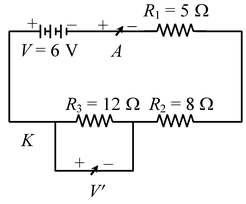
Ohm’s Law
Electricity of Class 10
The flow of electric current through a conductor depends on the potential difference across its ends. At a particular temperature, the strength of current flowing through it is directly proportional to the potential difference across its ends. This is known as Ohm's Law.
I ∝ V
or V ∝ I V = Potential difference
V = RI R = Resistance
or R = V/I, I = Current
Here, R is the constant of proportionality, which depends on size, nature of material and temperature. R is called the electrical resistance or resistance of the conductor.
EXPERIMENTAL VERIFICATION OF OHM'S LAW
- Set up a circuit as shown in figure consisting of a nichrome wire XY of length, say 0.5 m, an ammeter, a voltmeter and four cells of 1.5 V each. (Nichrome is an alloy of nickel, chromium, manganese, and iron metal.)
- First use only one cell as the source in the circuit. Note the reading in the ammeter I, for the current and reading of the voltmeter V for the potential difference across the nichrome wire XY in the circuit. Tabulate them.
- Next connect two cells in the circuit and note the respective readings of the ammeter and voltmeter for the values of current through the nichrome wire and potential difference across the nichrome wire.
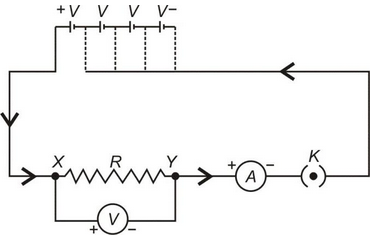
- Repeat the above steps using three cells and then four cells in the circuit separately.
- Calculate the ratio of V to I for each pair of potential difference (V) and current (I).
- Plot a graph between V and I, and observe the nature of the graph.
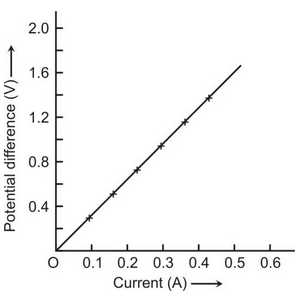
Thus, V/I is a constant ratio which is called resistance (R). It is known as Ohm’s Law.
RESISTANCE OF A CONDUCTOR:
The electric current is a flow of electrons through a conductor. When the electrons move from one part of the conductor to the other part, they collide with other electrons and with the atoms and ions present in the body of the conductor. Due to these collisions, there is some obstruction or opposition to the flow of electrons through the conductor.
The property of a conductor due to which it opposes the flow of current through it, is called resistance. The resistance of a conductor is numerically equal to the ratio of potential difference across its ends to the current flowing through it.
Resistance = Potential difference/Current, Or R = V/I
UNIT OF RESISTANCE
The S.I. unit of resistance is Ohm (Ω)
1 Ohm (Ω) = 1 volt(1V)/ Ampere(1 A)
The resistance of a conductor is said to be one ohm if a current of one ampere flows through it when a potential difference of one volt is applied across its ends.
CONDUCTORS, RESISTORS AND INSULATORS:
On the basis of their electrical resistance, all the substances can be divided into three groups:
conductors, resistors and insulators.
Conductors:
Those substances which have very low electrical resistance are called conductors. A conductor allows the electricity to flow through it easily. Silver metal is the best conductor of electricity Copper and Aluminium metals are also good conductors. Electric wires are made of Copper or Aluminium because they have very low electrical resistance.
Resistors:
Those substances which have comparatively high electrical resistance, are called resistors. The alloys like nichrome, manganin and constantan (or ureka), all have quite high resistances, so they are used to make those electrical devices where high resistance is required. A resistor reduces the current in the circuit.
Insulators:
Those substances which have infinitely high electrical resistance are called insulators. An insulator does not allow electricity to flow through it. Rubber is an excellent insulator. Electricians wear rubber handgloves while working with electricity because rubber is an insulator and protects them from electric shocks. Wood is also a good insulator.
CAUSE OF RESISTANCE:
There are many free electrons in a conductor. They move randomly when no electric current is passing through it. But when current is passed through it, they being negatively charged, start moving towards positive end of conductor, with a velocity called Drift velocity. During this movement, they collide with atoms, or ions of the conductor and thus their velocity is slowed down. This slow down due to obstruction is called Resistance.
Activity to show that the amount of current through an electric component depends upon its resistance:
- Take a nichrome wire, a torch bulb, a 10 W bulb and an ammeter (0-5 A range), a plug key and some connecting wires.
- Set up the circuit by connecting four dry cells of 1.5 V each in series with the ammeter leaving a gap XY in the circuit, as shown in figure.
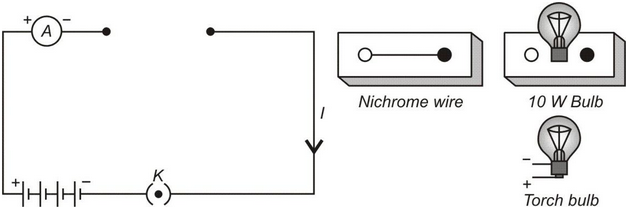
- Complete the circuit by connecting the nichrome wire in the gap XY. Plug the key. Note down the ammeter reading. Take out the key from the plug. [Note: Always take out the key from the plug after measuring the current through the circuit.]
- Replace the nichrome wire with the torch bulb in the circuit and find the current through it by measuring the reading of the ammeter.
- Now repeat the above step with 10 W bulb in the gap XY.
- You will notice that the ammeter readings differ for different components connected in the gap XY.
- You may repeat this Activity by keeping any material component in the gap. Observe the ammeter readings in each case. Analyse the observations.
Thus, we come to a conclusion that current through an electric component depends upon its resistance.
FACTORS AFFECTING RESISTANCE OF A CONDUCTOR
Resistance depends upon the following factors:-
(i) Length of the conductor.
(ii) Area of cross-section of the conductor (or thickness of the conductor).
(iii) Nature of the material of the conductor.
(iv) Temperature of the conductor.
Mathematically: It has been found by experiments that:
(i) The resistance of a given conductor is directly proportional to its length i.e.
R ∝ l ….(i)
(ii) The resistance of a given conductor is inversely proportional to its area of cross-section i.e.
R ∝ 1/A ….(ii)
From (i) and (ii), R ∝ 1/A
R = ρ x 1/A…(iii)
Where ρ (rho) is a constant known as resistivity of the material of the conductor. Resistivity is also known as specific resistance.
DEPENDANCY OF RESISTANCE ON TEMPERATURE:
If R 0 is the resistance of the conductor at 0°C and R1 is the resistance of the conductor at t°C then the relation between R0 and R1 is given by,
R 1 = R o (1 + θαΔt) [Here Δt = t – 0 = t]
Or

Here, a = Coefficient of Resistivity, t = temperature in °C
Experiment to show that resistance of a conductor depends on its length, cross section area and nature of its material.
- Complete an electric circuit consisting of a cell, an ammeter, a nichrome wire of length [marked (1)] and a plug key, as shown in figure.
- Now, plug the key. Note the current in the ammeter.
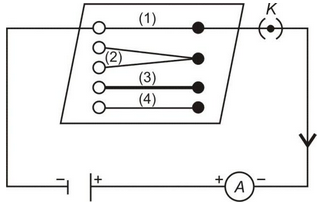
- Replace the nichrome wire by another nichrome wire of same thickness but twice the length, that is 2 [marked (2) in the figure].
- Note the ammeter reading.
- Now replace the wire by a thicker nichrome wire, of the same length [marked(3)]. A thicker wire has a larger cross-sectional area. Again note down the current through the circuit.
- Instead of taking a nichrome wire, connect a copper wire [marked (4) in figure] in the circuit. Let the wire be of the same length and same area of cross-section as that of the first nichrome wire [marked(1)]. Note the value of the current.
- Notice the difference in the current in all cases.
- We notice that the current depends on the length of the conductor.
- We also observed that the current depends on the area of cross-section of the wire used.
RESISTIVITY:
Resistivity, ρ = R x A/1….(iv)
By using this formula, we will now obtain the definition of resistivity. Let us take a conductor having a unit area of cross-section of 1 m 2 and a unit length of 1 m. So, putting A= 1 and l = 1 in equation (iv),
we get:
Resistivity, ρ = R
The resistivity of a substance is numerically equal to the resistance of a rod of that substance which is 1 metre long and 1 metre square in cross-section.
Unit of resistivity,

The S.I. unit of resistivity is ohm-metre which is written in symbols as Ω - m.
Resistivity of a substance does not depend on its length or thickness. It depends only on the nature of the substance. The resistivity of a substance is its characteristic property. So, we can use the resistivity values to compare the resistances of two or more substances.
Importance of resistivity:
A good conductor of electricity should have a low resistivity and a poor conductor of electricity should have a high resistivity. The resistivities of alloys are much more higher than those of the pure metals. It is due to their high resistivities that manganin and constantan alloys are used to make resistance wires used in electronic appliances to reduce the current in an electrical circuit.
Nichrome alloy is used for making the heating elements of electrical appliances like electric irons, room-heaters, water-heaters and toasters etc. because it has very high resistivity and it does not undergo oxidation (or burn) even when red-hot.
Effect of temperature on resistivity:
The resistivity of conductors (like metals) is very low. The resistivity of most of the metals increases with temperature. On the other hand, the resistivity of insulators like ebonite, glass and diamond is very high and does not changes with temperature. The resistivity of semi-conductors like silicon and germanium is in between those of conductors and insulators and decreases on increasing the temperature. Semi-conductors are proving to be of great practical importance because of their marked change in conducting properties with temperature and impurity concentration.
SPECIFIC USE OF SOME CONDUCTING MATERIALS:
Tungsten: It has high melting point of 3380ºC and emits light at 2127ºC. It is thus used as a filament in bulbs.
Nichrome: It has high resistivity and melting point. It is used as an element in heating devices.
Constantan and Manganin: They have modulated resistivity. Thus they are used for making resistances and rheostats.
Tin-lead Alloy: It has low resistivity and melting point. Thus it is used as fuse wire.
1. When a 12 V battery is connected across an unknown resistor, there is a current of 2.5 mA in the circuit. Find the value of the resistance of the resistor.
Solution: Given that voltage of battery V = 12 V
Circuit current I = 2.5 mA = 2.5 × 10 -3 A
∴ Value of resistance R = V/I = 12/ 2.5 x 10 3 = 4800 Ω
2. Redraw the circuit of illustration 11, putting in an ammeter to measure the current through the resistors and a voltmeter to measure the potential difference across the 12 Ω resistors. What would be the readings in the ammeter and the voltmeter?
Solution: The redrawn circuit is shown in figure. Here, ammeter A has been joined in series of the circuit and voltmeter V is joined in parallel to 12 Ω resistors.
Here total voltage of battery V = 3 × 2 = 6 V
Total resistance R = R1 + R2 + R3 = 5 + 8 + 12 = 25 Ω
∴ Ammeter reading = Current flowing in the circuit I = V/R = 6V/25 = 0.24A
∴ Voltmeter reading = Potential difference across 12 Ω resistor
V ' = IR 3 = 0.24 × 12 = 2.88 V
